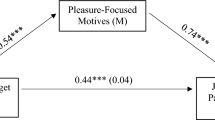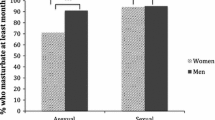Abstract
In contemporary society it is widely believed that men are socially rewarded for sexual activity, whereas women are derogated for sexual activity. To determine whether a sexual double standard exists, both undergraduate (n = 144) and Internet (n = 8,080) participants evaluated experimental targets who were described as either male or female and as having a variable number of sexual partners. Targets were more likely to be derogated as the number of sexual partners increased, and this effect held for both male and female targets. These results suggest that, although people do evaluate others as a function of sexual activity, people do not necessarily hold men and women to different sexual standards.
Similar content being viewed by others
References
Asch, S. E. (1952). Effects of group pressures upon the modification and distortion of judgments. In G. E. Swanson, T. M. Newcomb, & E. L. Hartley (Eds.), Readings in social psychology (pp. 393–401). New York: Holt, Reinhart, & Winston.
Barash, D. P., & Lipton, J. E. (2001). The myth of monogamy. New York: Freeman.
Cejka, M. A., & Eagly, A. H. (1999). Gender-stereotypic images of occupations correspond to sex segregation of employment. Personality and Social Psychology Bulletin, 25, 413-423.
Cohen, L. L., & Shotland, R. (1996). Timing of first sexual intercourse in a relationship: Expectations, experiences, and perceptions of others. Journal of Sex Research, 33, 291-299.
Crawford, M., & Popp, D. (2003). Sexual double standards: A review and methodological critique of two decades of research. Journal of Sex Research, 40, 13–26.
Ferrel, M. Z., Tolone, W. L., & Walsh, R. H. (1977). Maturational and societal changes in the sexual double-standard: A panel analysis (1967–1971; 1970–1974). Journal of Marriage and the Family, 39, 255–271.
Garcia, L. T. (1982). Sex-role orientation and stereotypes about male–female sexuality. Sex Roles, 8, 863–876.
Gentry, M. (1998). The sexual double standard. The influence of number of relationships and level of sexual activity on judgments of women and men. Psychology of Women Quarterly, 22, 505–511.
Gilovich, T. (1993). How we know what isn’t so: The fallibility of human reason in everyday life. New York: Free Press.
Lamb, S. (2002). The secret lives of girls: What good girls really do—sex play, aggression, and their guilt. New York: Simon and Schuster.
Lips, H. (1994). Female powerlessness: A case of “cultural preparedness”? In L. Radtke & H. Stam (Eds.), Power/gender—Social relations in theory and practice (pp. 89–107). London: Sage.
Malamuth, N. M., & Check, J. V. (1981). The effects of mass media exposure on acceptance of violence against women: A field experiment. Journal of Research in Personality, 15, 436-446.
Mark, M. M., & Miller, M. L. (1986). The effects of sexual permissiveness, target gender, subject gender, and attitude toward women on social perception: In search of the double standard. Sex Roles, 15, 311–322.
Marks, M. J. (2002). [Internet survey of attitudes of sexual freedom.] Unpublished raw data.
Milhausen, R. R., & Herold, E. S. (1999). Does the sexual double standard still exist? Perceptions of university women. Journal of Sex Research, 36, 361–368.
Milhausen, R. R., & Herold, E. S. (2001). Reconceptualizing the sexual double standard. Journal of Psychology and Human Sexuality, 13, 63–83.
MTV Networks Music. (2003, August 18). Fight for your rights: Busting the double standard[Television broadcast]. New York: MTV Networks Music.
Njikam-Savage, O. M., & Tchombe, T. M. (1994). Anthropological perspectives on sexual behaviour in Africa. Annual Review of Sex Research, 5, 50–72.
Okazaki, S. (2002). Influences of culture on Asian Americans’ sexuality. Journal of Sex Research, 39, 34–41.
O’Sullivan, L. F. (1995). Less is more: The effects of sexual experience on judgments of men’s and women’s personality characteristics and relationship desirability. Sex Roles, 33, 159–181.
Oliver, M. B., & Hyde, J. S. (1993). Gender differences in sexuality: A meta-analysis. Psychological Bulletin, 114, 29–51.
Oliver, M. B., & Sedikides, C. (1992). Effects of sexual permissiveness on desirability of a partner as a function of low and high commitment to relationship. Social Psychology Quarterly, 55, 321–333.
Richardson, L. (1997). Gender stereotyping in the English language. In L. Richrdson, V. Taylor, & N. Whittier (Eds.), Feminist frontiers V (pp. 112–116). New York: McGraw Hill.
Sheeran, P., Spears, R., Abraham, S. C. S., & Abrams, D. (1996). Religiosity, gender, and the double standard. Journal of Psychology, 130, 23–33.
Sherif, M. (1936). The psychology of social norms. New York: Harper and Row.
Snyder, M. (1981). Seek, and ye shall find: Testing hypotheses about other people. In E. T. Higgins, C. P. Herman, & M. P. Zanna (Eds.), Social cognition: The Ontario symposium on personality and social psychology. Hillsdale, NJ: Erlbaum.
Sprecher, S. (1989). Premarital sexual standards for different categories of individuals. Journal of Sex Research, 26, 232-248.
Sprecher, S., & Hatfield, E. (1996). Premarital sexual standards among U.S. college students: Comparison with Russian and Japanese students. Archives of Sexual Behavior, 25, 261-288.
Sprecher, S., McKinney, K., & Orbuch, T. L. (1987). Has the double standard disappeared? An experimental test. Social Psychology Quarterly, 50, 24–31.
Sprecher, S., McKinney, K., Walsh, R., & Anderson, C. (1988). A revision of the Reiss Premarital Sexual Permissiveness Scale. Journal of Marriage and the Family, 50, 821–828.
Tanenbaum, L. (2000). Slut! New York: Harper Collins.
Turner, J. C. (1991). Social influence. Bristol, PA: Open University Press.
Waggett, G. J. (1989, May 27). A plea to the soaps: Let’s stop turning rapists into heroes. TV Guide, pp. 10–11.
White, E. (2002). Fast girls: Teenage tribes and the myth of the slut. New York: Scribner.
Author information
Authors and Affiliations
Corresponding author
Rights and permissions
About this article
Cite this article
Marks, M.J., Fraley, R.C. The Sexual Double Standard: Fact or Fiction?. Sex Roles 52, 175–186 (2005). https://doi.org/10.1007/s11199-005-1293-5
Issue Date:
DOI: https://doi.org/10.1007/s11199-005-1293-5




